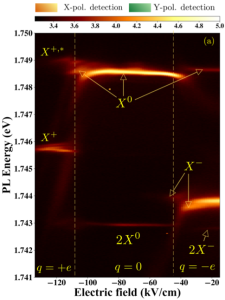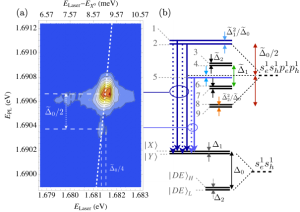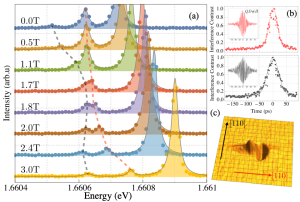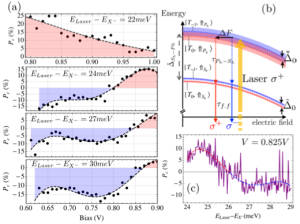List of members
Facilities
Internships and jobs
PhD
Publications
News
- Permanent staff : Benoit Eble, Valia Voliotis, Paola Atkinson
The NQMAG team at INSP (Paris Institute of NanoScience) is the only team in France studying GaAs/Al(1-x)GaxAs quantum dots (QDs) created by nanohole infilling. These QDs, emitting in the 720–800 nm wavelength range, offer unique advantages for quantum information applications, particularly due to their compatibility with rubidium-based quantum memories. Their growth method allows precise control over the density, shape, and wavelength of the QDs, providing optimal performance for indistinguishable single-photon sources. Additionally, the increased asymmetry of some QDs enables significant mixing of bright and dark excitonic states, making dark excitons optically active without the need for a transverse magnetic field. These QDs are also virtually strain-free, allowing nuclear spins to be used as quantum memories manipulated by radiofrequency pulses.
The current research conducted by the NQMAG team explores the interaction between electrons in the Gamma and X valleys for QDs with highly aluminum-concentrated barriers, as well as the coherent control of two-particle quantum states in systems of double epitaxial QDs coupled by tunneling effect.
- Recent publications :
- Probing intervalley coupling via exciton hybridization in a charge-tunable GaAs/AlAs quantum dot, Arnault Raymond, Paola Atkinson, Antoine Chapuis, Savvas Germanis, Florent Margaillan, Mathieu Bernard, Valia Voliotis, and Benoit Eble, PHYSICAL REVIEW B 112, 125302 (2025)
 |
In this study, we are examining a new GaAs/AlAs quantum dot architecture that facilitates coupling between electronic states in conduction band valleys Γ and Xz. This hybrid system supports both direct and indirect excitons. In this last configuration, the electron can be stabilized in the Xz-valley of either the upper or lower AlAs barrier. We employed polarization-resolved photoluminescence spectroscopy under electric fields to identify a double anti-crossing feature associated with the neutral exciton. This feature serves as a direct optical signature of inter-valley coupling at the single-dot level. The change in the sign of the Stark effect of the indirect transitions (observed at -105 and -40 kV/cm for X0) shows the electron jump from one barrier to another. This system allows for the precise control of the electron’s spatial position within the dot or surrounding barriers, while ensuring the hole’s precise location within the dot. This spatial control opens up new possibilities for quantum technologies, particularly in the manipulation of both the electron’s spin and position degrees of freedom. |
- Unveiling the spin-singlet states of two electron-hole pair complexes using two-photon excitation in a GaAs / AlAs quantum dot, Germanis, S.; Atkinson, P.; Bach, A.; Hostein, R.; Braive, R.; Vabre, M.; Margaillan, F.; Bernard, M.; Voliotis, V.; Eble, B., Rev. B. 105, 235430 (2022)

This article has been highlighted by the PRB editor as an “Editor’s Suggestion”. It presents a nonlinear optics experiment using two-photon excitation to initialize a biexciton state, i.e. two electron-hole pairs with different orbital states, in a GaAs quantum dot. The resolution of the complex fine structure is shown in detail in Fig. (b), and the distinctive signature of the two-photon resonance is illustrated in Fig. (a). Furthermore, our results demonstrate that this two-photon resonance provides a straightforward method for detecting the different spin singlet components, a task that is challenging with other experimental techniques. These discoveries pave the way for manipulating the spin states of electrons localized in high-energy orbitals in quantum manipulation protocols. - Emission properties and temporal coherence of the dark exciton confined in a GaAs/AlxGa1-xAs quantum dot, Germanis, S.; Atkinson, P.; Hostein, R.; Majrab, S.; Margaillan, F.; Bernard, M.; Voliotis, V.; Eble, B., Phys. Rev. B., 104, 115306 (2021)

This study explores a peculiar feature of GaAs/AlAs quantum dots, namely that dark excitons (electron-hole pairs with parallel spins), which are typically not coupled to photons, emit light, in contrast to InAs quantum dots. We interpreted this “anomaly” as caused by a symmetry breaking in the quantum dot, in particular due to the nano-hole in which it is formed (Fig. c, high-resolution AFM image). The symmetry reduction from C2v to Cs allows coupling via the electron-hole exchange term between the bright and dark excitons, giving the latter optical activity. We measured the intensity of this coupling by magneto spectroscopy, revealing an anticrossing (15 µeV @ 1.7 T) between the dark and bright branches (Fig. a), and compared its magnitude with a theoretical model. An unexpected observation emerged when measuring the widths of the interferograms of the dark and bright excitons from the same quantum dot, where the spectral width is dominated by nearby electrostatic fluctuations. We experimentally demonstrated that the interferogram width for the dark exciton is 30% larger, due to a subtle screening mechanism. This study highlights our experimental capability to measure extremely small quantities, as well as our deep understanding of excitonic physics in quantum dots.
Electrical control of optically pumped electron spin in a single GaAs/AlAs quantum dot fabricated by nanohole infilling, Germanis, S.; Atkinson, P.; Hostein, R.; Suffit, S.; Margaillan, F.; Voliotis, V.; Eble, B., Phys. Rev. B. 102, 035406 (2020)
 |
This work demonstrates the potential for electrically controlling the circularly polarized emission of the negatively charged trion (composed of two electrons and one hole) in a GaAs/AlAs quantum dot embedded in a field-effect structure. The trion’s negative polarization varies with the applied voltage (Fig. a) and the laser excitation energy (Fig. c), two parameters that influence the absorption of the higher energy spin triplet state (Fig. b). One of these states allows for the simultaneous flipping of the electron-hole pair, resulting in the trion’s circular polarization being opposite to the excitation laser’s circular polarization. This mechanism demonstrates the control of light polarization emitted by single-photon emitters, such as the GaAs/AlAs quantum dots used in this study, through electrical voltage pulses. |
- Useful reference books:
- Meier, F.; Zakharchenya, B. P. Optical Orientation (Modern Problems in Condensed Matter Sciences) . This book offers an in-depth and systematic analysis of various physical aspects of the orientation of electron and nuclear spins in semiconductors by optical means.
- M. Dyakonov, “SPin Physics in Semiconductors” (Springer):This book offers an extensive introduction to the extremely rich and fascinating field of spin-related phenomena in semiconductors. In this second edition, all chapters have been updated to include the latest experimental and theoretical research. Furthermore, it covers the entire field: bulk semiconductors, two-dimensional semiconductor structures, quantum dots, optical and electric effects, spin-related effects, electron-nuclei spin interactions, Spin Hall effect, spin torques, etc. Thanks to its self-contained style, the book is ideally suited for graduate students and researchers new to the field.
- M. Glazov, “Electron & Nuclear spin dynamics in semiconductor nanostructures” : In recent years, nanoscience has experienced a revival of interest in spin effects in solid state systems. On one hand, solid state systems, particularly semiconductors and semiconductor nanosystems, allow us to perform studies of quantum and relativistic phenomena in the laboratory. On the other hand, this interest is supported by the prospects of realizing spin-based electronics, where the electron or nuclear spins may play the role of quantum or classical information carriers. This book looks in detail at the physics of coupled systems of electron and nuclear spins in semiconductors, with particular emphasis on low-dimensional structures.

